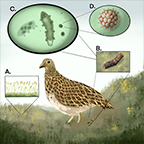It started with a search for bryophyte fragments in the feces of high Andean birds on Navarino island (see post) when Michael Robertson and Nicholas Russo (former EEB student now at UCLA) discovered tardigrades in the samples. Their observation are now published in Polar Biology.
Robertson M.W., N.J. Russo, S.J. McInnes, B. Goffinet & J.E. Jiménez. 2020. Potential dispersal of tardigrades by birds through endozoochory: evidence from sub-Antarctic White-bellied Seedsnipe (Attagis malouinus). Polar Biology in press.
Abstract reads: Tardigrades are potentially dispersed by birds, but the extent of the interactions between birds and tardigrades is virtually unknown. We discovered nine tardigrades within feces of White-bellied Seedsnipe (Attagis malouinus) collected from high Andean tundra on Navarino Island, Chile. Eight of the tardigrade specimens began moving once rehydrated. Two specimens belonged to the genus Adropion (Hypsibiidae), one to the Macrobiotus (Macrobiotidae), and five could not be identified. A ninth specimen was a species of Isohypsibius in an embryonic egg state. These tardigrades could have passed through the avian digestive tract after incidental ingestion or burrowed into the feces post-defecation to feed on microorganisms and undigested plant matter present in the feces. To our knowledge, this is the first discovery of tardigrades in bird feces and may have implications for tardigrade distributions if birds transport tardigrades endogenously.
